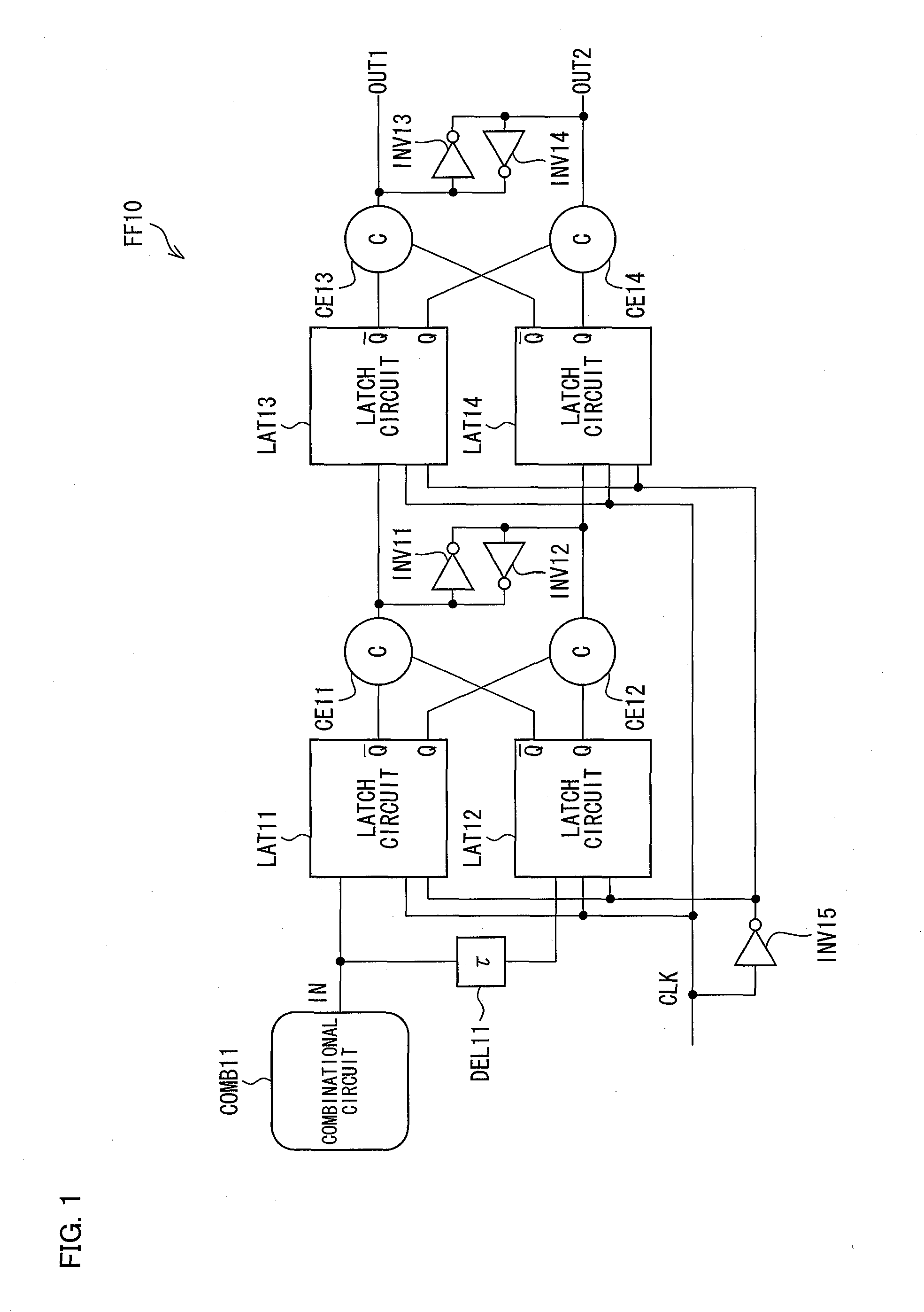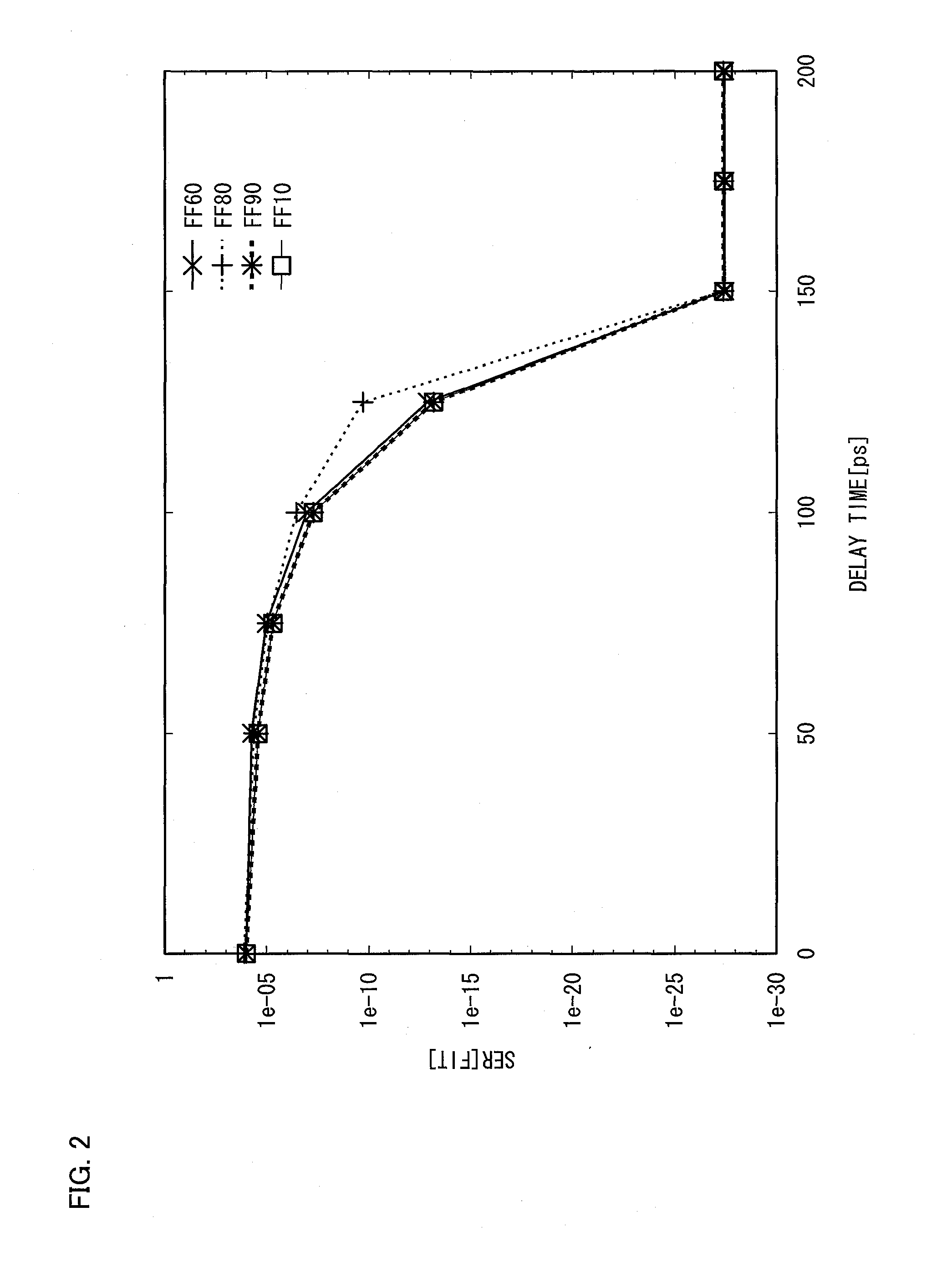Flip-flop circuit, semiconductor device and electronic apparatus
- Summary
- Abstract
- Description
- Claims
- Application Information
AI Technical Summary
Benefits of technology
Problems solved by technology
Method used
Image
Examples
embodiment 1
[0060]One embodiment of the present invention is described below with reference to FIGS. 1 through 21.
(Configuration of Flip-Flop Circuit of the Present Embodiment)
[0061]FIG. 1 is a view illustrating a configuration of a flip-flop circuit FF 10 of the present embodiment. The flip-flop circuit FF 10 is a flip-flop circuit that retains input data IN supplied from a combinational circuit COMB 11. The flip-flop circuit FF 10 includes (i) two master latch circuits LAT 11 and LAT 12, (ii) two slave latch circuits LAT 13 and LAT 14, (iii) four C-element circuits CE 11, CE 12, CE 13, and CE 14, (iv) five inverter circuits INV 11, INV 12, INV 13, INV 14, and INV 15, and (v) a delay circuit DEL 11.
[0062]The master latch circuits LAT 11 and LAT 12 correspond to a first master latch circuit and a second master latch circuit recited in Claims, respectively. An input terminal of the master latch circuit LAT 11 receives input data IN from the combinational circuit COMB 11. Further, an input termin...
example 1
[0081]In order to prove that a flip-flop circuit of the present invention has a higher resistance to an error than that of a conventional flip-flop circuit, the following experiment was carried out.
[0082]As illustrated in FIG. 7, eight flip-flop circuits FF 10 of the present invention were cascade-connected to each other, so as to constitute a shift register. Two selector circuits SEL 11 and SEL 12 were connected to a flip-flop circuit FF 10 provided at a first stage. One of input terminals of the selector circuit SEL 11 received an input signal SI, and one of input terminals of the selector circuit SEL 12 received an inverted input signal bar SI. Moreover, the other one of input terminals of the SEL 11 was connected to one of data output terminals of a flip-flop circuit FF 10 provided at the last stage, and the other one of input terminals of the selector circuit SEL 12 was connected to the other one of data output terminals of the flip-flop circuit FF 10 provided at the last stage...
example 2
[0090]Further, the inventors of the present invention carried out an experiment in which a shift register was irradiated with a neutron ray. Eight flip-flop circuits FF 10 of the present invention were cascade-connected to each other, so as to constitute a shift register (see FIG. 7). Eight conventional flip-flop circuits FF 90 were cascade-connected to each other, so as to constitute another shift register. Each of the shift registers was irradiated with a neutron ray, and, for each of the shift registers, the number of errors generated in a predetermined time period was counted. As a result, in a case where an operating frequency of the circuits was 100 MHz, the number of errors in the shift register constituted by the flip-flop circuits FF 10 was approximately 31% of the number of errors in the shift register constituted by the flip-flop circuits FF 90. Further, in a case where an operating frequency of the circuits was 10 MHz, the number of errors in the shift register constitut...
PUM
 Login to View More
Login to View More Abstract
Description
Claims
Application Information
 Login to View More
Login to View More - R&D
- Intellectual Property
- Life Sciences
- Materials
- Tech Scout
- Unparalleled Data Quality
- Higher Quality Content
- 60% Fewer Hallucinations
Browse by: Latest US Patents, China's latest patents, Technical Efficacy Thesaurus, Application Domain, Technology Topic, Popular Technical Reports.
© 2025 PatSnap. All rights reserved.Legal|Privacy policy|Modern Slavery Act Transparency Statement|Sitemap|About US| Contact US: help@patsnap.com



